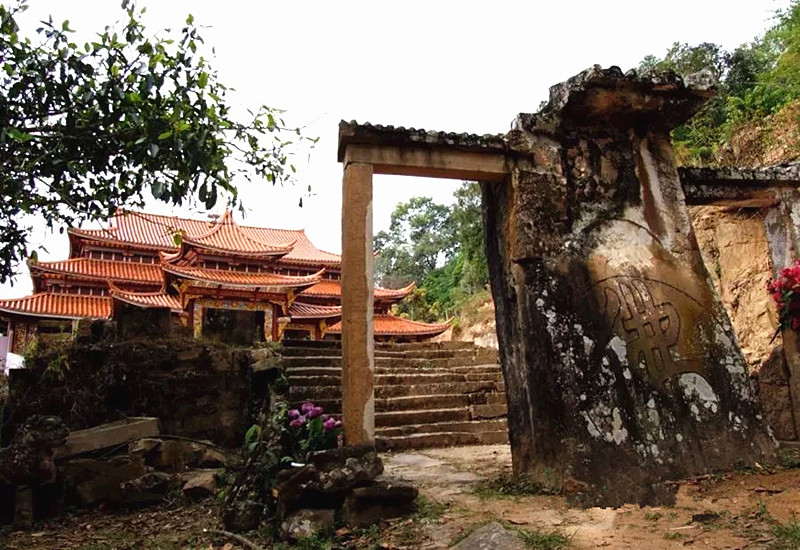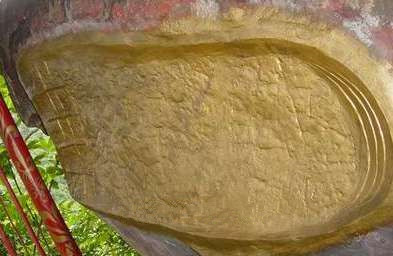
Leiguang Temple (Daxianrenjiao Temple) in Jinggu County, Puer
Overview
Leiguang Temple (雷光佛迹寺, Léi Guāng Fó Jì Sì), also known as Daxianrenjiao Temple (大仙人脚佛寺, Dàxiān Rénjiǎo Sì), is located in Yongping Town (永平镇, Yǒngpíng Zhèn), Jinggu County (景谷县, Jǐnggǔ Xiàn), Puer City (普洱市, Pǔ’ěr Shì), Yunnan Province, China. Established in the 50th year of the Qianlong reign (乾隆, Qiánlóng) during the Qing Dynasty, this temple is a significant site of Theravada Buddhism. Inside the temple, there are four large footprints said to be left by the Buddha upon his ascension to heaven.
Entrance and Stone Archway
Upon arriving at the entrance of Leiguang Temple, visitors encounter a stone archway that, although modest in size, exudes an ancient charm. The archway lacks surrounding walls, and its two empty doorways enhance the spacious atmosphere. A large character “佛” (Fó, meaning “Buddha”) is inscribed prominently in the center, encircled by a ring, signifying the entrance to the sacred Buddhist realm. This gate symbolizes not just a physical entrance, but a spiritual passage into the world of Buddhism.
Couplets and Inscriptions
As I climbed the steps, I glanced back at the inscriptions on the back of the stone archway:
- Upper Couplet: “不是一凡苦行未知何处觅仙迹” (Not just ordinary asceticism; where do I seek the traces of immortals?)
- Lower Couplet: “若非百计踌躇那得斯地有名山” (If not for countless hesitations, how would this place be known as a famous mountain?)
- Horizontal Inscription: “大皈依光生就西弥” (The great refuge shines towards the West.)
These couplets reflect the literary artistry of ancient scholars. The central inscription details the time and person who erected the monument: “乾隆五十年丙午住持护朝瞻鼎,孟春月款旦立” (In the 50th year of Qianlong, during the year of Bingwu, the abbot Huchao Zhanding erected this stone monument in Mengchun).
Main Hall and Buddha Footprints
Upon respectfully entering the main hall, I was greeted by the serene image of the Buddha seated on a lotus pedestal. The compassionate expression on his face conveyed his mission of saving and aiding humanity. At the foot of the Buddha, a massive rock displays four overlapping footprints, representing the Buddha’s journey to enlightenment:
- First Footprint: Left by Gaga Shengta, who practiced for 40,000 years before ascending.
- Second Footprint: Left by Ge Nagama, who practiced for 30,000 years before ascending.
- Third Footprint: Left by Gasaiba, who practiced for 20,000 years before ascending.
- Fourth Footprint: Left by Guo Dama, also known as Shakyamuni.
According to legend, Shakyamuni’s mother passed away shortly after his birth, yet he could walk immediately, leaving a lotus flower with each step. He is said to have ascended around 470 BC. During his ascent, he left a peacock and a golden rooster to guard his footprints, awaiting the arrival of the fifth Buddha. However, as the fifth Buddha could not achieve enlightenment, the peacock and rooster ascended on their own, leaving their marks on nearby stones.
Sacred Well
Below the giant footprint rock, a small well reveals itself. Regardless of the season, the sweet, clear water in this well never runs dry or overflows. It is considered holy water with the power to heal various ailments. Visitors are encouraged to bring a bottle of this water home for its supposed healing properties.
Cultural Significance and History
The abbot warmly welcomed us, providing detailed explanations of the temple’s various artifacts, paintings, and the origins of the Buddha’s footprints. This introduction helped us appreciate the historical context of Leiguang Temple.
According to records, as early as the 1147th year of the Dai calendar (1733 AD), a monk from Cangyuan traveled from Gengma and Shuangjiang to Mengga. After witnessing golden Buddha light radiating from the peak of Laiguanhan Mountain at dusk, he ventured alone up the mountain and discovered the sacred footprints.
Bilingual Inscription
In the temple, there exists a bilingual monument inscribed in both Chinese and Dai languages, showcasing the cultural exchange between Han (汉, Hàn) and Dai (傣, Dǎi) cultures. The monument stands 3 meters tall and 1.5 meters wide, featuring a large character “佛” on the front and a detailed historical account of the temple’s establishment on the back.
How to Get There
Leiguang Temple is accessible by bus or private car from Puer City. The journey typically takes around 2-3 hours. Local transportation options, such as taxis, are available for visitors to reach the temple directly from the nearest towns.
Travel Tips
- Best Time to Visit: Spring and autumn offer pleasant weather for exploration and photography.
- Cultural Sensitivity: Be respectful of local customs and traditions while visiting the temple.
- Water Supply: Bring a bottle to collect the sacred well water.
- Comfortable Footwear: Wear appropriate shoes for walking and climbing steps.
- Photography: Capture the stunning scenery and intricate temple architecture, but be mindful of areas where photography may be restricted.




















